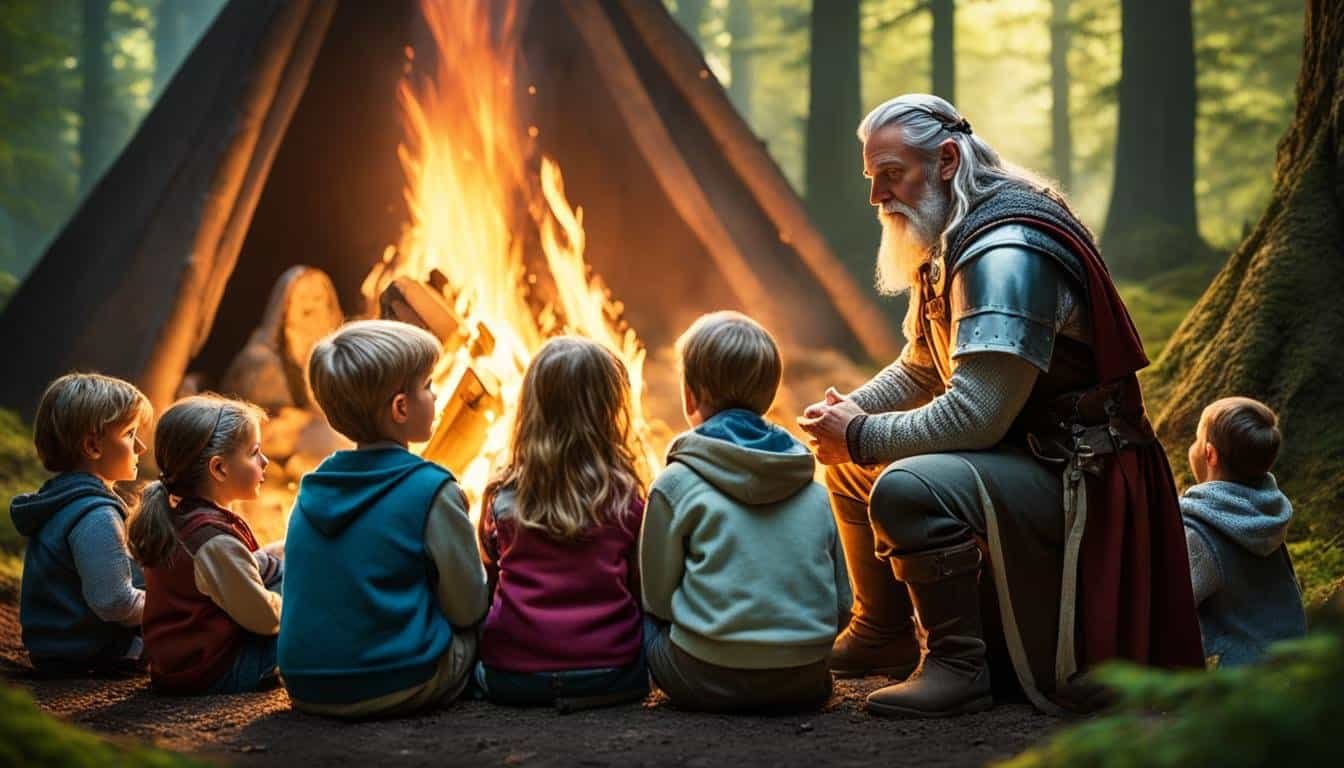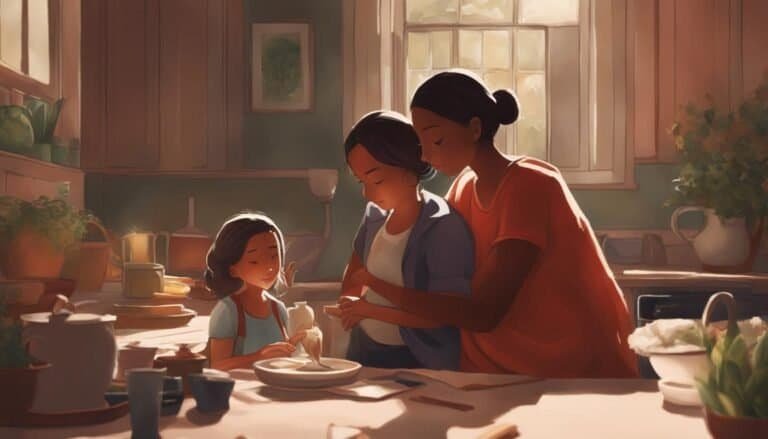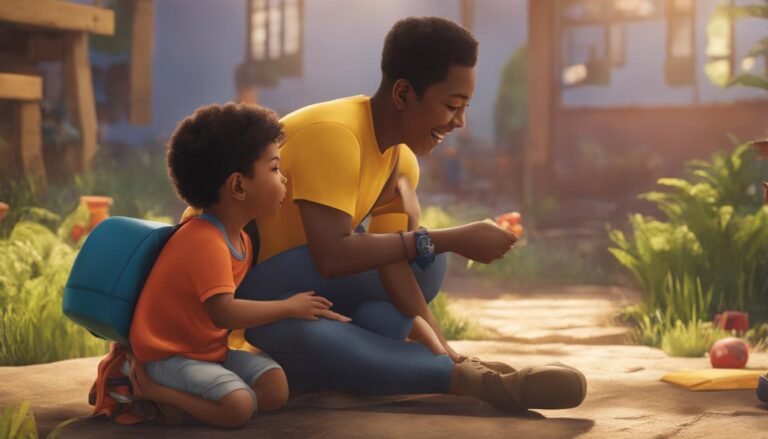Exciting History for Kids – Engaging Tales
History for Kids is an online platform dedicated to providing engaging and educational history resources for children. Our mission is to make history come alive through interactive lessons, fun activities, and age-appropriate materials. With a wide range of topics and captivating tales, we aim to spark children’s curiosity and foster a love for learning about the past.
At History for Kids, we believe that learning about history should be an enjoyable experience. We offer a variety of resources, including articles, worksheets, quizzes, games, videos, and more, to make history learning exciting and interactive. Our content is designed to captivate children’s imaginations and encourage them to explore the fascinating world of the past.
Key Takeaways:
- History for Kids provides engaging and educational resources for children to learn about history.
- We offer interactive lessons, fun activities, and age-appropriate materials to make history learning enjoyable.
- Our platform covers a wide range of topics and provides captivating tales to spark children’s curiosity.
- Through our resources, children can develop a deeper understanding of historical events and cultures.
- We aim to ignite a passion for learning and inspire children to explore the fascinating world of history.
Discovering Ancient Egypt
Embark on a captivating journey through the ancient civilization of Egypt with History for Kids. This educational website provides a wealth of information about the daily lives of ancient Egyptians, their impressive architectural achievements, and their remarkable contributions to science.
Step back in time and uncover the secrets of ancient Egypt’s daily life. Explore how the ancient Egyptians lived, what they ate, how they dressed, and the various roles they played in society. From the grand pharaohs to the hardworking farmers, children can gain a deeper understanding of the rich tapestry that was ancient Egypt’s social structure.
As you delve further into this fascinating civilization, discover the remarkable advancements in fields such as metalwork and papermaking. Ancient Egyptians were skilled craftsmen who mastered the art of creating intricate jewelry and tools. They also developed a form of early paper called papyrus, which revolutionized the way information was recorded and preserved.
The breathtaking architecture of ancient Egypt is a testament to the ingenuity and skill of its people. From awe-inspiring pyramids to intricate temples, the monumental structures of ancient Egypt continue to marvel us today. Learn about the construction techniques used by ancient Egyptians and uncover the secrets behind their enduring architectural marvels.
No exploration of ancient Egypt would be complete without diving into their scientific achievements. Marvel at their understanding of astronomy, mathematics, and medicine. Discover how their advanced knowledge of science allowed them to create calendars, build irrigation systems, and develop effective medical treatments.
Unearth the wonders of ancient Egypt with History for Kids and ignite a sense of wonder and curiosity in children. Through interactive learning experiences, captivating visuals, and engaging content, children can immerse themselves in the rich history of this extraordinary civilization.
“Ancient Egypt is a treasure trove of history and culture, and by exploring its mysteries, we can gain invaluable insights into the past.”
A Glimpse into Ancient Egyptian Daily Life
Gain a deeper understanding of the daily lives of the ancient Egyptians through the following highlights:
- Roles and social structure in ancient Egyptian society
- Fascinating details about ancient Egyptian food and clothing
- Insights into the daily routines of different social classes
Architectural Marvels of Ancient Egypt
Discover the impressive architectural achievements of ancient Egypt through the following highlights:
- The engineering secrets behind the awe-inspiring pyramids
- The intricate design and symbolism of ancient Egyptian temples
- The monumental structures that have stood the test of time
Advancements in Egyptian Science
Uncover the scientific achievements of ancient Egypt through the following highlights:
- The ancient Egyptians’ understanding of astronomy and its importance
- The mathematical knowledge that enabled the construction of their architectural wonders
- The medical practices and treatments developed in ancient Egypt
Visual Insights – Ancient Egyptian Artifacts
| Artifact | Description |
|---|---|
| An exquisitely crafted golden mask of Tutankhamun, showcasing the intricate metalwork of ancient Egypt. |
Journey to Ancient Greece
Step back in time and explore the ancient civilization of Greece with History for Kids. Ancient Greece, which flourished nearly 4000 years ago, holds a significant place in history with its remarkable contributions to science, captivating sculptures, and rich mythology.
Children can delve into the enthralling world of Greek history, where great philosophers like Socrates, Plato, and Aristotle shaped the foundations of Western thought. Discover the birthplace of democracy, the Olympic Games, and the origins of drama and poetry.
Take an immersive journey through the vibrant streets of Athens and witness the grandeur of ancient Greek architecture, epitomized by iconic structures like the Parthenon. Marvel at the stunning sculptures that have influenced art for centuries, such as the famous statue of Zeus at Olympia and the breathtaking Venus de Milo.
Greek mythology comes alive as children explore the captivating tales of gods and goddesses like Zeus, Athena, and Poseidon. They can uncover the secrets of Mount Olympus, the home of the gods, and embark on epic adventures with heroes like Hercules and Odysseus.
Immerse yourself in the mysteries of Greek religion, where beliefs shaped the daily lives of ancient Greeks. Learn about the solemn rituals, sacred temples, and important deities that played a vital role in their society.
Through engaging articles, interactive activities, and vibrant visuals, History for Kids offers a comprehensive understanding of ancient Greece, fostering a love for learning and a deeper appreciation of this influential civilization.
Greek Contributions to Science
| Field | Notable Contributions |
|---|---|
| Mathematics |
|
| Astronomy |
|
| Medicine |
|
| Philosophy |
|
| Engineering |
|
| Physics |
|
As children explore the wonders of ancient Greece, they will gain a deeper appreciation for the lasting impact of this remarkable civilization on science, art, and culture.
Exploring the Roman Empire
The Roman Empire, known as one of the most influential civilizations in history, offers a fascinating glimpse into the past. Through the History for Kids website, children can embark on a journey through time and discover the wonders of this ancient empire. From its mighty conquests to the intricate details of daily life, the Roman Empire paints a vivid picture of a bygone era.
Medieval Literature:
While the Roman Empire itself may have fallen, its legacy continued to shape the world during medieval times. Children can delve into the captivating realm of medieval literature and explore tales of chivalry, romance, and adventure. From the epic works of authors like Geoffrey Chaucer to the timeless legends of King Arthur, medieval literature offers a captivating glimpse into the imaginations of the past.
Medieval Architecture:
The architecture of the Middle Ages provides a striking contrast to the grandeur of the Roman Empire. Children can marvel at the towering cathedrals, majestic castles, and intricate stained glass windows that defined this period. Through detailed descriptions and stunning visuals, History for Kids brings medieval architecture to life, allowing children to appreciate the skill and artistry of the builders and craftsmen of the time.
Medieval Daily Life:
What was life like for ordinary people during the Middle Ages? History for Kids offers insight into the daily lives of medieval peasants, knights, and nobles. Children can learn about the feudal system, the role of chivalry, and the customs and traditions that governed medieval society. By exploring the daily life in the medieval era, children gain a deeper understanding of the challenges and triumphs experienced by people of the time.
The Crusades:
The Crusades were a series of religious wars fought during the medieval period. Through History for Kids, children can explore the causes, events, and consequences of the Crusades. They can learn about the motivations of the Crusaders, the clashes between different cultures, and the impact of these wars on both Europe and the Middle East. The Crusades offer a window into the complex interactions and conflicts of the medieval world.
“The Roman Empire and the medieval period are like two sides of the same coin. By exploring both, children can gain a deeper understanding of the transitions, influences, and continuities that shaped Western civilization.”
Contrasting the Roman Empire and Medieval Times
| Roman Empire | Medieval Times |
|---|---|
| Centralized and expansive empire | Feudal system with fragmented power |
| Polytheistic religion | Christianity as the dominant religion |
| Emphasis on civic virtues and public works | Focus on feudal loyalty and fortified castles |
| Extensive trade networks | Localized economies |
| Influenced by Greek and Hellenistic culture | Influenced by Christianity and Germanic traditions |
Uncovering History in Asia
History for Kids offers a wealth of information on the captivating history of Asia. Children can embark on an exciting journey as they explore various aspects of Asian history, including daily life, literature, and art. By delving into these topics, children gain a deeper understanding of the rich cultural heritage and diverse traditions of this fascinating region.
Asian history encompasses a vast timeline of civilizations, dynasties, and empires that have shaped the continent. From the majestic wonders of ancient China to the philosophical teachings of ancient India, there is much to discover. Through the extensive resources provided by History for Kids, children can explore historical events, influential figures, and the societal structures of Asian civilizations.
One intriguing aspect of Asian history is daily life in Asia. Children can learn about the customs, traditions, and routines of people who lived centuries ago. They can explore the unique clothing styles, culinary traditions, and even the recreational activities that were prominent in different time periods. Understanding the daily life of people in ancient Asia offers a glimpse into the past and provides valuable insights into the challenges and triumphs of their lives.
Asian literature is another significant component of the continent’s history. From ancient epics like the “Ramayana” and “Mahabharata” of India to the classic works of Chinese poetry and Japanese haiku, Asian literature showcases the creativity, wisdom, and storytelling traditions of different cultures. Through the resources offered by History for Kids, children can explore excerpts from these literary masterpieces and gain appreciation for the rich literary heritage of Asia.
Asian art is renowned for its beauty, intricacy, and symbolism. Children can journey into the world of Asian art, witnessing the craftsmanship and expressions of creativity that have endured throughout history. From delicate Chinese porcelain and vibrant Indian textiles to the graceful paintings of Japan, the art of Asia reflects the distinct cultural identities and aesthetic sensibilities of different regions. History for Kids provides images of these stunning artworks, offering children an opportunity to appreciate and understand the significance behind them.
| Aspect | Description |
|---|---|
| Daily Life in Asia | Explore customs, traditions, and routines of ancient Asian civilizations. |
| Asian Literature | Discover literary works from India, China, Japan, and other Asian cultures. |
| Asian Art | Witness the beauty and symbolism of Asian art through stunning examples. |
Uncovering history in Asia opens a world of knowledge, understanding, and appreciation for the vibrant cultures and civilizations that have flourished on this continent. Through History for Kids, children can embark on an exciting educational journey, immersing themselves in the wonders of Asian history, daily life, literature, and art.
Discovering Ancient China
Children can immerse themselves in the fascinating history of ancient China through the resources provided by History for Kids. As they delve into this ancient civilization, they will gain insights into the daily lives of ancient Chinese people, their art, architecture, and literature.
Ancient Chinese daily life offers a glimpse into the customs and traditions of this rich culture. From the food they consumed to the games and music they enjoyed, children can explore the vibrant aspects of Chinese daily life.
| Chinese Daily Life | Chinese Art | China Architecture | Chinese Literature |
|---|---|---|---|
|
|
|
|
Chinese art showcases the mastery of calligraphy, painting, and sculpture. Children can appreciate the beauty and intricacy of these art forms and gain an understanding of their cultural significance.
China architecture is renowned for its iconic structures such as the Great Wall, the Forbidden City, and majestic pagodas. Exploring these architectural marvels allows children to appreciate the skill and craftsmanship of ancient Chinese builders.
Chinese literature, including poetry, classical novels, and philosophical writings, provides a glimpse into the intellectual and creative achievements of ancient Chinese authors. Children can discover the profound ideas and stories that have shaped Chinese culture.
“Chinese daily life, art, architecture, and literature offer a glimpse into the vibrant and enduring legacy of this ancient civilization.” – History for Kids
Understanding the Importance of History
History is the study of the past as narrated in written documents. It allows us to gain knowledge and insights about the events, people, and cultures that have shaped the world we live in today. Historians play a crucial role in uncovering and interpreting historical records, piecing together the puzzle of the past.
“The study of history is a window into our collective human experience, offering valuable lessons and perspectives.”
By studying history, we can better understand the triumphs and challenges of civilizations that came before us, learn from their successes and failures, and appreciate the progress we have made over time. Historical records provide a wealth of information that allows us to reconstruct past events, unravel historical mysteries, and gain a deeper appreciation for the complexity of human society.
History for Kids aims to instill in children an appreciation for the study of the past and the value it holds. By providing a wide range of historical information, interactive activities, and engaging resources, History for Kids seeks to spark curiosity and empower children to explore and learn about the world’s rich history.
Why is history important for children?
Understanding history is crucial for children as it helps them develop a sense of identity and belonging, fosters critical thinking skills, promotes cultural awareness, and deepens their understanding of the world around them. Through the study of history, children can:
- Gain knowledge about the past and how it influences the present
- Develop a sense of empathy and understanding of different perspectives
- Enhance their critical thinking and analytical skills
- Appreciate the diversity of cultures and societies
- Recognize patterns and make informed decisions based on past events
Exploring historical records
Historical records serve as the foundation for historical research and provide valuable primary sources for historians. These records can include manuscripts, letters, diaries, photographs, government documents, and more. They allow historians to piece together a chronological narrative, analyze multiple perspectives, and draw insights from the past.
Uncovering hidden stories
History is not merely a collection of facts and dates; it is a tapestry of stories waiting to be unveiled. Through historical research and interpretation, historians can shed light on untold stories, amplify marginalized voices, and challenge dominant narratives. These hidden stories provide a more comprehensive understanding of the past and contribute to a more inclusive and accurate depiction of history.
The role of historians
Historians play a crucial role in examining, interpreting, and sharing historical knowledge. They analyze historical records, conduct research, and present their findings through various mediums such as books, articles, and educational resources. By critically examining the past, historians contribute to our collective understanding of history and inspire continuous exploration and discovery.
Through History for Kids, children can embark on a journey of exploration, discovering the importance of history and developing a lifelong love for learning about the past.
The Benefits of Stories for Kids
Stories for kids have numerous benefits that go beyond simple entertainment. They play a crucial role in their development, helping them in various aspects of their lives. Whether it’s through reading books, listening to audio stories, or engaging with interactive digital content, stories have a profound impact on children’s growth. Let’s explore some of the key advantages:
Promoting Language Development
Stories are a fantastic tool for language development in children. By exposing them to a wide range of words, phrases, and sentence structures, stories help expand their vocabulary and improve their comprehension skills. Listening to stories also enhances their oral language abilities, enabling them to express themselves fluently and with confidence.
Fostering Imagination
Imagination is a vital aspect of a child’s cognitive development. Stories fuel their imagination, taking them on incredible adventures and introducing them to new places, characters, and ideas. Through storytelling, children can let their creativity soar, developing their imaginative thinking skills and expanding their horizons.
Facilitating Cultural Understanding
Stories provide a window into different cultures, traditions, and perspectives. They expose children to diverse experiences and help them cultivate empathy and understanding for others. By reading stories set in different parts of the world or featuring characters from various backgrounds, children gain a deeper appreciation for different cultures and learn to embrace diversity.
Encouraging Emotional Intelligence
Stories often touch upon various emotions and challenges that characters face, allowing children to explore and understand their own feelings. They learn about empathy, kindness, and compassion as they connect with the emotions of the characters. Through these emotional journeys, stories help children develop their emotional intelligence and build stronger relationships with others.
Aiding Cognitive Development
Engaging with stories stimulates children’s cognitive abilities, such as memory, attention span, and critical thinking. Following storylines, predicting outcomes, and making connections between events sharpens their analytical skills. Stories also expose children to different problem-solving strategies and encourage them to think creatively, enhancing their cognitive development.
Building Communication Skills
Listening to stories provides an excellent opportunity for children to improve their communication skills. They learn to listen actively, pay attention to details, and comprehend complex ideas. Additionally, discussions about the stories they read or hear encourage them to express their thoughts, opinions, and ideas effectively.
History for Kids understands the significance of stories in a child’s growth and learning journey. That’s why our educational resources incorporate engaging narratives that captivate young minds and ignite their curiosity about the past. By blending storytelling with historical facts, we create a unique and immersive learning experience that fosters a deeper understanding of history and its connections to the world today.
Through stories, children unlock their imagination, develop language skills, gain cultural understanding, and embark on exciting adventures. The power of storytelling cannot be underestimated, as it shapes young minds and helps them grow into curious, empathetic, and knowledgeable individuals.
Sharing Stories with Children
Sharing stories with children is a magical experience that goes beyond mere entertainment. It is a powerful tool for parent-child bonding and an opportunity to foster their development on multiple levels. Reading to children introduces them to the wonders of storytelling and sparks their imagination, while simultaneously nurturing their communication skills, vocabulary development, and more.
When you read to children, you create a special bond, a shared experience filled with warmth and love. As you snuggle up together with a book, you not only share the joy of a good story but also create cherished memories that will last a lifetime. The personal connection formed through storytelling helps children feel secure and valued, strengthening the parent-child relationship.
Moreover, reading to children enhances their communication skills. Listening to the words, they learn about sentence structure, grammar, and pronunciation, which are essential components of effective communication. By engaging in conversations about the story, children also develop their ability to express themselves and articulate their thoughts and feelings.
Through stories, children are transported to different worlds, both real and imaginary. They use their imagination to visualize characters, settings, and events, stimulating their creativity and encouraging them to think beyond the ordinary. Storytelling stimulates curiosity, as children eagerly anticipate what will happen next and ask questions that deepen their understanding of the narrative.
By reading a variety of stories to children, you open the door to a broader worldview. Stories from different cultures expose children to diverse perspectives, fostering an appreciation for diversity and promoting empathy. As they encounter characters with different backgrounds, beliefs, and experiences, children learn to understand and respect others, contributing to the development of their social and emotional intelligence.
Storytelling is also an excellent tool for vocabulary development. By exposing children to a rich and varied language, stories introduce new words and phrases in context, helping them expand their vocabulary and strengthen their comprehension skills. Through repeated exposure, children develop a deeper understanding of words and their meanings, further enhancing their language skills.
Furthermore, storytelling ignites children’s curiosity about the world and history. Historical stories transport them to different eras and civilizations, allowing them to explore the past and learn about different cultures. Through these stories, children gain historical knowledge, develop a sense of time and sequence, and begin to grasp the concept of cause and effect.
To create a positive and enriching reading environment, History for Kids encourages parents and caregivers to share stories with children regularly. Explore the vast collection of historical stories and interactive resources available on our website, and embark on an exciting journey of discovery with your little ones. Together, you can immerse yourselves in captivating narratives that inspire, educate, and foster a lifelong love for reading and learning.
| Benefits | Description |
|---|---|
| Parent-Child Bonding | Reading together creates a special bond and cherished memories. |
| Communication Skills | Listening to stories improves language skills and encourages conversation. |
| Imagination | Storytelling sparks creativity and encourages thinking beyond the ordinary. |
| Cultural Understanding | Stories from different cultures promote empathy and appreciation for diversity. |
| Vocabulary Development | Exposure to a rich language strengthens vocabulary and comprehension skills. |
| Curiosity and Knowledge | Historical stories stimulate curiosity and provide insights into different eras and civilizations. |
The Power of Short Stories for Kids
Short stories for kids can be incredibly impactful in their learning and development journey. These stories not only capture their attention but also play a crucial role in expanding their vocabulary and teaching them essential life lessons. Additionally, short stories promote diversity, inclusivity, and critical thinking skills, fostering a well-rounded growth in children.
When children engage with short stories, they actively participate in recognizing different sounds, words, and language patterns. This helps in enhancing their language skills and comprehension abilities. Moreover, short stories encourage children to think critically by presenting them with various characters, situations, and problems to analyze and understand.
One of the key benefits of short stories for kids is the valuable life lessons they impart. Through relatable characters and captivating plotlines, children can learn about kindness, empathy, resilience, and the importance of making good choices. These stories provide children with powerful examples that resonate with them, helping them internalize these lessons and apply them to their own lives.
Promoting Diversity and Inclusivity
Short stories have the ability to introduce children to diverse cultures, traditions, and perspectives. They offer a platform to celebrate differences and foster a sense of inclusivity. By representing characters from various backgrounds and communities, short stories empower children to appreciate diversity and develop empathy.
“Short stories have the remarkable ability to transport children into different worlds, exposing them to new ideas and perspectives. They enable children to develop a broader understanding of the world and the people in it.” – History for Kids
Incorporating short stories that reflect the rich tapestry of human experiences allows children to embrace different cultures and broaden their horizons. These stories create opportunities for discussion and reflection, encouraging children to question their own biases and promoting a more inclusive mindset.
The Development of Critical Thinking Skills
Short stories provide children with the chance to engage in critical thinking activities. By analyzing characters, their motivations, and the choices they make, children develop their ability to think independently and critically evaluate different perspectives. They learn to identify cause and effect relationships, recognize patterns, and make connections between the story and the real world.
Furthermore, as children experience a variety of storylines and narrative structures, they develop creative thinking skills. Short stories spark their imagination, allowing them to explore different possibilities and think outside the box. This creativity and open-mindedness can benefit children in various aspects of their lives, from problem-solving to artistic expression.
The power of short stories in a child’s learning journey cannot be overstated. Through engaging narratives, these stories facilitate language development, teach important life lessons, promote diversity, and encourage critical thinking skills. History for Kids recognizes the immense value of incorporating short stories into educational resources, harnessing their potential to inspire and educate children.
| Benefits of Short Stories for Kids | Examples |
|---|---|
| Expanding vocabulary | Introducing new words and phrases through context |
| Teaching life lessons | Developing empathy, resilience, and moral values |
| Promoting diversity and inclusivity | Exploring different cultures and perspectives |
| Encouraging critical thinking | Analyzing characters, motivations, and choices |
| Fostering creativity | Inspiring imagination and outside-the-box thinking |
Conclusion
History for Kids is a treasure trove of engaging and educational resources that allow children to embark on a fascinating journey through time. With its interactive learning experiences and age-appropriate materials, History for Kids makes history come alive for young learners. Through fun activities, children can acquire knowledge about historical events, civilizations, and cultures, while also developing a deeper understanding of the world around them.
By presenting history in an accessible and enjoyable way, History for Kids aims to ignite a passion for learning and foster a lifelong curiosity about the past. The engaging history content provided on the website captivates children’s attention and helps them connect with the stories of the past. Whether it’s exploring ancient Egypt, discovering ancient Greece, uncovering the wonders of the Roman Empire, or diving into the rich history of Asia, History for Kids offers a diverse range of educational resources that cater to every child’s interests.
With History for Kids, children can embark on an interactive learning journey that goes beyond textbooks. They can delve into captivating historical narratives, solve history-themed puzzles and quizzes, and watch educational videos that bring history to life. The website’s commitment to providing age-appropriate materials ensures that children can explore history in a safe and suitable environment.
History for Kids is not just about acquiring knowledge; it’s about fostering a love for history and nurturing critical thinking skills. Through the combination of engaging content, fun activities, and interactive learning, History for Kids empowers children to develop a deeper appreciation for the significance of the past and its impact on the present.







